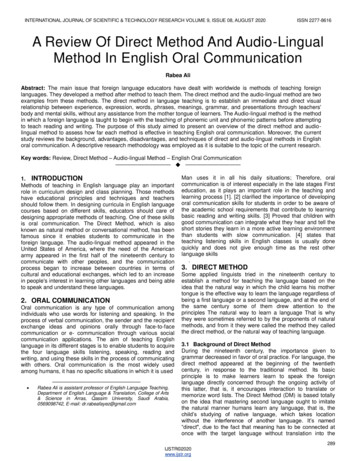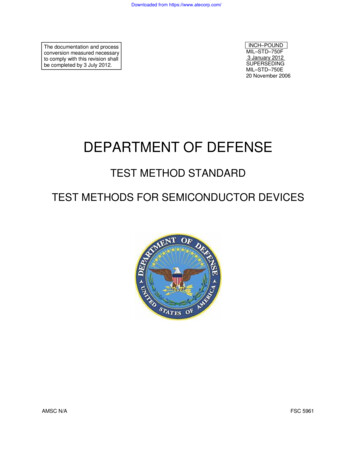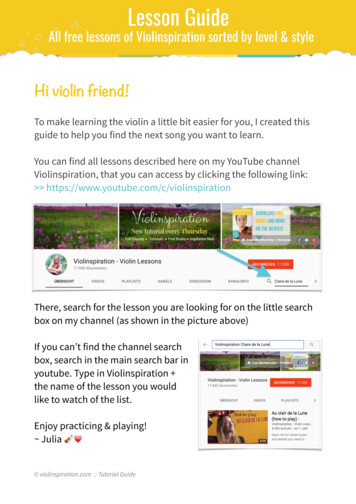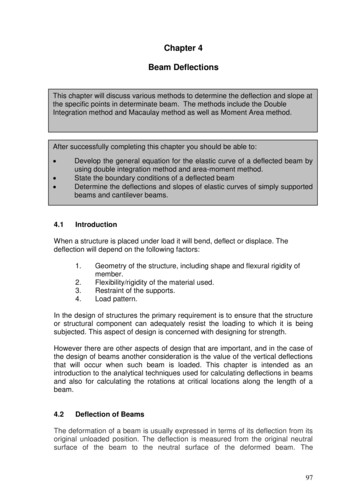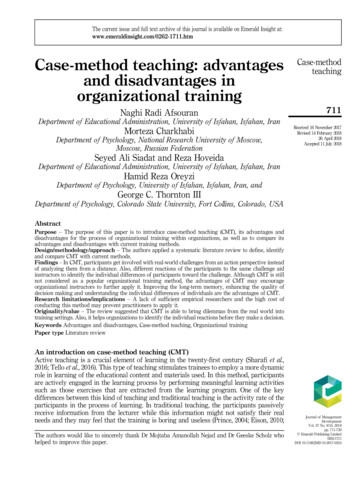
Transcription
The current issue and full text archive of this journal is available on Emerald Insight at:www.emeraldinsight.com/0262-1711.htmCase-method teaching: advantagesand disadvantages inorganizational trainingNaghi Radi AfsouranCase-methodteaching711Department of Educational Administration, University of Isfahan, Isfahan, IranMorteza CharkhabiDepartment of Psychology, National Research University of Moscow,Moscow, Russian FederationReceived 16 November 2017Revised 14 February 201826 April 2018Accepted 11 July 2018Seyed Ali Siadat and Reza HoveidaDepartment of Educational Administration, University of Isfahan, Isfahan, IranHamid Reza OreyziDepartment of Psychology, University of Isfahan, Isfahan, Iran, andGeorge C. Thornton IIIDepartment of Psychology, Colorado State University, Fort Collins, Colorado, USAAbstractPurpose – The purpose of this paper is to introduce case-method teaching (CMT), its advantages anddisadvantages for the process of organizational training within organizations, as well as to compare itsadvantages and disadvantages with current training methods.Design/methodology/approach – The authors applied a systematic literature review to define, identifyand compare CMT with current methods.Findings – In CMT, participants get involved with real-world challenges from an action perspective insteadof analyzing them from a distance. Also, different reactions of the participants to the same challenge aidinstructors to identify the individual differences of participants toward the challenge. Although CMT is stillnot considered as a popular organizational training method, the advantages of CMT may encourageorganizational instructors to further apply it. Improving the long-term memory, enhancing the quality ofdecision making and understanding the individual differences of individuals are the advantages of CMT.Research limitations/implications – A lack of sufficient empirical researchers and the high cost ofconducting this method may prevent practitioners to apply it.Originality/value – The review suggested that CMT is able to bring dilemmas from the real world intotraining settings. Also, it helps organizations to identify the individual reactions before they make a decision.Keywords Advantages and disadvantages, Case-method teaching, Organizational trainingPaper type Literature reviewAn introduction on case-method teaching (CMT)Active teaching is a crucial element of learning in the twenty-first century (Sharafi et al.,2016; Tello et al., 2016). This type of teaching stimulates trainees to employ a more dynamicrole in learning of the educational content and materials used. In this method, participantsare actively engaged in the learning process by performing meaningful learning activitiessuch as those exercises that are extracted from the learning program. One of the keydifferences between this kind of teaching and traditional teaching is the activity rate of theparticipants in the process of learning. In traditional teaching, the participants passivelyreceive information from the lecturer while this information might not satisfy their realneeds and they may feel that the training is boring and useless (Prince, 2004; Eison, 2010;The authors would like to sincerely thank Dr Mojtaba Amanollah Nejad and Dr Geeske Scholz whohelped to improve this paper.Journal of ManagementDevelopmentVol. 37 No. 9/10, 2018pp. 711-720 Emerald Publishing Limited0262-1711DOI 10.1108/JMD-10-2017-0324
JMD37,9/10712Wandberg et al., 2011). In reaction to the disadvantages of the traditional methods, newteaching methods such as CMT have been developed. Although there is still no agreementabout the origins of CMT, some researchers stated that it was preliminarily used by the LawSchool of Harvard University in 1870 (Shugan, 2006), and by the French Institutions at thebeginning of the twentieth century (Tripathy, 2009).CMT is an active teaching technique with the potential to enhance the quality and quantityof an individual’s learning (Razali and Zainal, 2013). CMT initially referred to the description of areal situation of an event and contained episodes of practice, a slice of life, a story designed andpresented as study material, and an exercise as a puzzle or a problem (Barnes et al., 1994).More recently, CMT is characterized as a type of active instructor-guided teaching, whichemphasizes the importance of discussion-based learning (Razali and Zainal, 2013). CMTintroduces complicated, obscure real world or fabricated cases (scenarios) into an educationalsetting in which a protagonist is encountered with a significant decision (Razali and Zainal, 2013;Liubchenko, 2016).CMT has the potential to immerse participants into realistic managerial situations in orderto detect how they make decisions while having incomplete information, time constraints andconflicting goals. It also enriches each hour of learning through adding more examplesand experiences within the process of learning. The enriched environment stimulatesparticipants to think more deeply and to present their opinions more freely. In this method, notonly the instructor is able to see how participants react differently to a challenge/problem, butalso it helps participants to see how their points of view vary concerning differentorganizational issues. This helps participants increase their learning and have fun too.As such, a large body of studies has demonstrated the positive impact of CMT on a widerange of academic and educational outcomes. For example, CMT promotes academicperformance (Schunk et al., 2012), critical thinking (Bowe et al., 2009), motivation to participatein class activities (Murray-Nseula, 2012), self-efficacy (Yalcinkaya et al., 2012) and oral andwritten communication skills among students (Bonney, 2015). These studies represent theimportance of CMT in academic settings; however, less is known about the application ofCMT within organizations. CMT can be considered an important asset to organizationsbecause it can train employees to more efficiently deal with the challenges of theirorganizational roles. As such, the first aim of this paper is to discuss CMT, its advantages anddisadvantages in the organizational training process. In this regard, recent studies show thatthe classical teaching methods such as instructor-based teaching or trainee-based teachingcarry limitations. One of the major limitations of these methods is that they ignore theindividual differences of the participants within the learning process (Hoyt and Lee, 2002;Gregory and Chapman, 2012). The individuals’ differences include the interests and needs ofparticipants to the educational materials and their different learning styles. Therefore, weneed to look for a more specific teaching method to reduce the limitations of previous trainingmethods. In CMT, successful instructors simultaneously manage content and process morerigorously and learn to balance planning and spontaneity. In practice, they pursueopportunities and “teachable moments” that emerge throughout the discussion, and deftlyguide trainees toward discovery and learning on multiple levels (Christensen Center forTeaching and Learning, 2017).The second aim of this paper is to introduce CMT as a tool to address the limitations ofprevious methods. This aim will be discussed in more detail in the next section. We structurethis paper based on the following sections: first, we talk about the research method of thisstudy. Then, we describe the theoretical foundation of CMT. Next, we discuss how CMT canbe used to compensate for the limitations of other teaching methods in educational programswithin the organizations. Then, we will discuss how to run a CMT within an organization.We will follow this with a discussion of the advantages and disadvantages of using CMT fororganizations and we will end up with conclusions and suggestions for the future.
Research method of this studyWe applied a systematic literature review to identify, define and compare CMT with currentmethods. In this regard, we searched in the databases of PsycINFO, ScienceDirect andGoogle Scholar using keywords of CMT, learning cycle theory, organizational trainingand individual differences. In all, we obtained 153 relevant articles from PsycINFO,101 articles from ScienceDirect and 840 articles from Google Scholar. After we furtherreviewed these articles and set additional filters, we chose 39 final articles which containedmost relevant information regarding the CMT and developed following sections.Case-methodteaching713Theoretical foundation of CMTCMT is mainly based upon the learning cycle theory developed by Kolb (1984) and improvedby Honey and Mumford (1992). According to this theory, an efficient learning is achievedthrough a four continuous cycling stages process (Honey and Mumford, 1992): experiencingstage: learners should have some activities to increase their experiences; reviewing stage:learners should think about what has happened, or think about the available problem, andreflect its outcomes; concluding stage: learners should analyze and synthesize the informationof previous stages to draw some conclusions and generalize it; and planning stage: learnersshould test observations, reflections and subsequent conclusions and look for new ideas thatcan be applied to the problem and decide what to do in the future. Figure 1 shows the diagramof a learning cycle based on the learning cycle theory.CMT can be modeled in a similar way using learning cycle theory (Burgoyne andMumford, 2001). In CMT, instructors teach trainees on a main subject related to their jobposition through: presenting information about relevant cases or requesting participantsto play the role of those cases (containing some elements of experiencing and reviewingstages); facilitating a discussion among trainees to analyze these cases, and to reacha conclusion about the main subject (containing some elements of the concluding stage);encouraging trainees to review those findings that they gained in the previous stages andto decide on what to do in the future as a next relevant subject (containing some elementsof planning stage); and restarting the same cycle for studying another subject related totheir job position (Burgoyne and Mumford, 2001; Beckisheva et al., 2015; Yun et al., 2016).As an example, imagine that an occupational health psychologist intends to trainPlanning thenext stepsHaving anexperienceConcludingfrom theexperienceReviewingtheexperienceSource: Honey and Mumford (1992)Figure 1.The diagram of alearning cycleaccording toKolb theory
JMD37,9/10714employees on “What the positive stress is in the workplace?” According to theaforementioned steps, the instructor could arrange the following stages:(1) Instructor describes the condition of a case very briefly. For example, this case couldbe a manager who has positive stress in his workplace. Instructor helps trainees toshare their information and experiences of similar cases (experiencing andreviewing stages).(2) Instructor opens a discussion among trainees to measure the understanding of thetrainees of this case. The instructor encourages trainees to draw a conclusion aboutthe concept of positive stress (concluding stage).(3) Instructor encourages the trainees to review their conclusions and present theirideas about a relevant subject such as “if positive stress is good so how can weincrease positive stress?” (planning stage).This cycle can be re-started from the first stage by studying the next relevant issue in theplanning stage ( for more complex examples see: Brooke, 2006; Bowe et al., 2009;Jianli, 2012; Beckisheva et al., 2015). Indeed, instructors try to engage the trainees in acontinuous learning cycle and transform inactive learners into active learners. Burgoyneand Mumford (2001) claimed that where the participants of a CMT program do notinitially understand the subject of their program, they still can share their experiences andinformation with each other or they still can learn about the subject by participating inactivities such as role playing. The learning cycle theory provides a solid theoreticalfoundation on how CMT can enhance the training process within organizations(Honey and Mumford, 1992).Influence of individual differences on CMTThe demographic and psychological characteristics of individuals distinguish oneindividual from another. Individual differences refer to the extent and type of distinctionsamong individuals on some of the significant psychological factors. Individual differencesare essential when we tend to explain how individuals differ in their behavior. We can studyindividual differences in factors such as personality, intelligence, memory or learning. Manyof a learner’s personal characteristics can affect how he or she learns (Revelle et al., 2011).The study of individual differences among learners can aid educators design instructionsthat better match each learner’s needs. As such, it is important to consider the individualdifferences when CMT is used to transfer the educational materials from an instructor to atrainee (Nazimuddin, 2015). We introduce two classical teaching methods to compare itsability in paying attention to these differences compared to CMT. According to De laSablonnière et al. (2009), we refer to two classical teaching methods. First, instructorcentered, which introduce the instructor as the main source of knowledge, expecting fromthe learners to follow the directions and information of their instructor. Second, learnercentered which emphasize the needs and the abilities of the learners, placing the instructorin the role of a facilitator, rather than simply imparting knowledge.Both methods have their own limitations. Instructor-centered methods mainly neglectthe active role of learners in learning, while learner-centered methods mainly neglect thelearning role of instructors (Yun et al., 2016). Besides, it seems that the instructor-centeredmethods oversee the individual differences of learners including their learning styles,personality and motivation (Gregory and Chapman, 2012). In contrast, the learnercentered methods oversee the same individual differences among instructors (such astheir teaching style or work personality) (Hoyt and Lee, 2002). Although these limitationsare related to the individuals in an academic setting, similar limitations can also beassumed when individuals work in an organizational setting. CMT, as a modern training
method, compensates for the limitation of the aforementioned methods in the ignorance ofindividual differences. In this respect, Yun et al. (2016) stated that the main practical valueof CMT is its flexibility (without focusing exclusively on either instructors or learners) inmatching the teaching styles of instructors with the individual aspects of learners.Use of CMT within organizationCMT instructors use cases because they believe that learners learn more when they areinvolved with the cases. They learn from the cases to formulate the real problems and makedifficult decisions under the conditions of uncertainty. In this procedure, learnerssimultaneously discover (or construct) a body of knowledge and master life learning skills(Golich, 2000). Although the literature shows that CMT has been widely used in educationalsettings, it has rarely been applied in organizational training. As such, we propose to showhow CMT can be used in organizational learning using following steps.Case-methodteaching715Step 1: providing prerequisitesInstructors should determine some key aspects of a subject before they use this method.This helps learners to improve their learning from the educational materials. This includesdeciding on the topic of an educational course, its goals and cases related to the educationalmaterials, sufficient knowledge about different dimensions of the cases, preparing questionsin advance and predicting where learners may run into problems (Garvin, 2003).Step 2: preparing traineesInstructors should have a preparation program for their trainees before they select andarrange the cases for teaching (Schwartz, 2007). For example, instructors directly help andinstruct trainees, set aside many blank and blind spots for trainees to explore.Step 3: selection and arrangement of the casesThis step contains considerations on the topic of cases such as: if they should be simple orcomplex; if the cases contain a small or large amount of knowledge; if trainees areunfamiliar/familiar with the cases; and if the cases are true or made-up (Yun et al., 2016).Step 4: presentation and analysis of the casesThis step contains considerations about how to present the cases in a variety of ways,including textual form, oral form, situational simulation, video, etc. The different forms ofpresentation should be compatible with the nature of the case (Bowe et al., 2009).The process of running a CMT program is displayed in Figure 2.Each of these subsections is accompanied by a written guidance or a supplementaryvideo. As Figure 2 shows, the CMT program has a specific running structure that allowsinstructors to pre-screen each step before moving to a next step. Also, the flexible structureaids instructors to look at the educational material from a trainee point of view. In additionto this, the specific running structure considers both characteristics of the instructors andthe trainees simultaneously. According to Damrongpanit and Reungtragul (2013), anProvidingprerequisitesPreparingtraineesSelection andarrangement ofthe casesSources: Bowe et al. (2009) and Yun et al. (2016)Presentation andanalysis of thecasesFigure 2.The Processof running aCMT program
JMD37,9/10716efficient learning in the instructor-centered methods mostly requires a class in which aninstructor acts with a direct lecture-based style and a trainee act with a theorist learningstyle (Honey and Mumford, 1992; Renau Renau, 2016). In contrast, an efficient learning inthe trainee-centered methods often requires a class in which an instructor has a cooperativeteaching style and a trainee follows a realistic learning style (Damrongpanit andReungtragul, 2013). Yet et al. (2013) believed that both of these teaching methods have somelimitations: in the instructor-centered method, instructors with direct instruction style find italmost impossible to improve the learning rate of trainees who follow a realistic learningstyle; and in the trainee-centered method, the learning rate of trainees with theorist learningstyles often cannot be improved by the instructor who follows a lecture-based style. CMT isable to fill this gap by employing its specific running structure in which both characteristicsof instructors and trainees are considered important elements of a learning process.This means that CMT needs to determine the teaching style of an instructor and learningstyle of a trainee before the program begins. As such, this flexibility can help instructors topersonalize their teaching style (e.g. direct instructors with theorist trainees or cooperativeinstructors with realistic trainees) to a particular trainee or group before they begin it.This feature enables instructors to choose appropriate tools and cases for their course aswell as to improve the learning rate of the trainees. For example, instructors using lecturebased style may want to apply a verbal and auditory content/tool to enhance the learningrate of their theorist trainees. On the contrary, cooperative instructors may use someanalytical materials to promote the learning rate of their realistic trainees.As an example, imagine a situation in which an instructor uses CMT to train staff on“stress management.” The instructor may encourage trainees to state their ideas on the termof “stress management,” guide them to get enough knowledge about the term (e.g. introducingthem resources such as books and articles), introduce them cases in which the staff reducedtheir stress (e.g. the method of Mr X faced with a stressful issue; the method of Mr Y, insolving his managerial conflict) and analyze the reasons for the ability/inability of cases tocope with the stress through brainstorming. For example, Mr X may have positiveinterpretation on stressful issues and Mr Y perhaps is optimist facing the conflict.Advantages and disadvantages of CMT for organizationsCMT provides noticeable advantages for employees and organizations at both the personaland organizational levels. At the personal level, learners “do” the work of the discipline byengaging in the selected cases and applying the concepts, techniques and methods of thatdiscipline rather than merely watching or reading how the things are done by others(Kleinfeld, 1990). Thereby, tacit knowledge and skills can be trained. Also, case-relateddiscussions charge the circumstances of education with additional energy and excitement andprovide an opportunity in which learners can work with a wide range of evidence andinformation by which they can improve their ability in applying theories, vocabularies andmethods during the learning course (Roberts and Ryrie, 2014). It also prepares participants toencounter inexperienced situations, to learn about the complexity of these situations, to learnhow they can apply their previous knowledge and problem-solving skills in such situations, towork together effectively and to connect learning material with reality (Gray et al., 2006;Watson and Sutton, 2012). CMT contributes to study the individual differences of participantsbased on their demographic and psychological characteristics leading to explore the learningdifferences of participants. All these advantages could happen in the process ofimplementation of CMT in a training program. This attention aids learners to follow theeducational materials actively and at a greater depth, rather than a situation in whichparticipants are only passive recipients of knowledge (Kleinfeld, 1990; Gray et al., 2006;Watson and Sutton, 2012; Austin and Sonneville, 2013; Roberts and Ryrie, 2014). At theorganizational level, CMT enables organizations to empower their staff through the practice of
real-world challenges, to compare the competitive potential of their organization with otherorganizations, to visualize the challenges and opportunities ahead of their organization, toexplore solutions for unexpected problems and to benefit from the participation ofprofessional employees in their decision making.Besides these advantages, the high cost, the time-consuming process of conducting thismethod and the limited number of empirical research may limit practitioners to apply itmore broadly (Chen et al., 2006). Moreover, to build an appropriate case, practitioners willneed to dig in inside and outside the organization and take into consideration all the futuregoals and orientations of the organization which is time consuming. At the personal level,there is a probability of bias because of the demographic and psychological characteristicsof the trainees. These biases might be more important when the trainees want to disclosetheir private information regarding a case or when the trainees are too shy to easily discussa selected case. Additionally, trainees need to have high concentration and attention levels,strong listening and speaking skills, critical and analytical thinking in the whole process ofthe implementation of CMT. In doing so, they may experience fatigue, stress or concernduring a CMT-based program. Therefore, we should be open to accept that not allemployees may like or be suitable to participate in a CMT. This indicates that the voluntaryelement of participation should always remain as an important issue when we invitecandidates to attend a CMT program. That is why we probably have to conduct a CMTusing a selected sample, rather than a random sample. Otherwise, some ethical issues mayarise which are not the concern of this paper.Conclusion and outlookWe used a systematic literature review to define CMT and to figure out its potentialadvantages and disadvantages in organizational training. Our review suggests that comparedto the traditional teaching methods, CMT can better visualize the opportunities and challengesahead of an organization. Moreover, as our review suggested that there is a solid theoreticalfoundation, such as learning cycle theory, to develop a CMT for a particular target group orfor a specific training program. To support these conclusions, we present the implications ofCMT in two following classifications: theoretical implications and practical implications.Theoretical implicationsCMT can be suggested to those researchers who would like to substitute new teachingmethods with traditional methods. This paper figured out new research gaps between thesetwo teaching styles that can be filled by empirical and field studies. In this respect,researchers may want to investigate the extent to which the individual differences ofparticipants or their pre-knowledge may influence a CMT compared to the traditionalteaching methods. Also, further research is needed to identify how to develop an appropriatecase for a CMT. Designing a mechanism to evaluate the effectiveness of the CMT would beanother needed research area for researchers. This paper also provided theoreticalexplanations, extracted from the learning cycle theory, to support all stages of a CMT and toenrich the literature of CMT.Practical implicationsCMT can be suggested to those organizational practitioners who would like to apply aflexible and personalized way of teaching for their trainees. The practitioners can adjusttheir teaching style with the specific profile of the target trainees. This matching processnot only facilitates the teaching process for the instructor but it can also help traineeslearning the educational material with their preferred learning style, which in turn canalso increase the learning rate of them. In addition, practitioners can benefit to teachCase-methodteaching717
JMD37,9/10718complex topics to their employees while they consider their individual differences towardthe topics. CMT would be particularly an excellent choice for those times that anorganization wants to make substantial changes to their structures but the organization isunable to predict how the employees may react to these changes. In other words, CMTupholds the predictability of organizations to prevent possible problems/challenges fromarising by bringing those problems/challenges from a real-world situation into a trainingsetting where trainees have enough time and energy to analyze these challenges. Inaddition to this, the sporadic reactions of employees and managers can be understoodbefore they actually encounter the situations. Therefore, it is the features of CMT thatincrease the power of organizational decision makers to reduce the unpredictability aspectof events and the “know-do” gap. Moreover, the organizational decision makers will havea better understanding of the weaknesses and strengths of their employees when they arefaced with such unpredictable events. Consequently, they can empower them before theyface a real dilemma or problem. Providing this information by organizational practitionershelps organizational decision makers to make changes to the position of those employeeswho are unable to react efficiently to an expected threat or they may decide to hold someparticular educational programs to improve these employees. Although until now thescientific evidence shows that CMT provides many advantages in facilitating the processof learning at the individual and organizational levels, we recommend that organizationalpractitioners be skeptical when they use it in practice. This can be understood due to somelimitations of this method and indeed that is a major reason that we suggest CMT as asupplementary method in this paper.Limitations of CMTThe first limitation can be related to the difference between the independent andsupplementary teaching styles. Independent methods build upon rich literatureand sufficient empirical research to support the whole processes (planning,implementation and evaluation) while supplementary methods, such as CMT, still need tobe examined (particularly within an organizational context). Other reason is relatedto insufficient empirical evidence to evaluate the positive outcomes of CMT outside theteaching place. Besides, there are still challenges ahead of using CMT as a supplementarymethod. Some of those are: finding sensible topic-based cases to elucidate individualdifferences, the high cost of the implementation of this method, the education oforganizational practitioners to teach based on CMT and the pre-knowledge of participantsthat may vary from one to another and lead to misunderstandings between practitionersand participants. In this paper, we did not have access to real examples of problematiccases/events to present within the text and that would be a limitation of our study.To reduce these limitations, we recommend the CMT instructors to advise the participantsabout the aims, materials and procedure of a CMT before they attend. This would facilitatedynamic and active discussions between the instructor and participants and promote theprocess of learning in a CMT.ReferencesAustin, S.B. and Sonneville, K.R. (2013), “Closing the ‘know-do’ gap: training public healthprofessionals in eating disorders prevention via case-method teaching”, International Journal ofEating Disorders, Vol. 46 No. 5, pp. 533-537.Barnes, L.B., Christensen, C.R. and Hansen, A.J. (1994), Teaching and the Case Method: Text, Cases, andReadings, Harvard Business Press, Cambridge, MA.
Beckisheva, T.G., Gasparyan, G.A. and Kovalenko, N.A. (2015), “Case study as an active method ofteaching business English”, Procedia – Social and Behavioral Sciences, Vol. 166, pp. 292-295.Bonney, K.M. (2015), “Case study teaching method improves student performance and perceptions oflearning gains”, Journal of Microbiology & Biology Education, Vol. 16 No. 1, pp. 21-28.Bowe, C.M., Voss, J
Keywords Advantages and disadvantages, Case-method teaching, Organizational training Paper type Literature review An introduction on case-method teaching (CMT) Active teaching is a crucial element of learning in the twenty-first century (Sharafi et al., 2016; Tello et al., 2016). This type of teaching stimulates trainees to employ a more dynamic


